Virtual environment lab opens at the CC
 |
| NHGRI Social and Behavioral Research Branch staff scientist Dr. Susan Persky observes NHGRI scientific director Dr. Eric Green interacting in a virtual environment through a headpiece displaying computer-generated 3-D images and a handheld pointer. |
|
NHGRI’s Immersive Virtual Environment Testing Area, located in 10-6C401 next to the Occupational Medical Service, opened in June to conduct the first of many social and behavioral research studies at the Clinical Center.
The concept of using virtual reality technology in research and health care is not new. But the research lab is the first facility to combine the two and ask questions about how to promote health, prevent disease, and improve health care, according to NHGRI staff.
Social and Behavioral Research Branch investigator Dr. Kim Kaphingst’s protocol, "Using Virtual Reality to Test Communication Strategies for Genomic Concepts," will be the first study to use the new lab.
After completing a pilot test phase at the University of California-Santa Barbara that included 40 participants, Kaphingst is seeking 150 people ages 18 to 40 to come to the CC for the study’s next phase.
Study participants will be healthy adult volunteers without specialized genetics knowledge so that the study can see how the general public learns best about the topic. Each participant will answer an initial questionnaire, complete one 15-minute activity in the virtual arena, and then complete a test of how they remember the content that was presented or apply that material to new situations.
To preserve the integrity of the study, the investigators can’t reveal the topics of the virtual reality environments, except to say that they deal with genetics. Participants will see the virtual environment through a headpiece and use a handheld pointer, which functions as an extension of the hand, to make selections in the computer-generated scenarios. An investigator in the room with the participant sees the images in the headpiece on a computer screen.
NHGRI plans future studies exploring how to teach genomic concepts, the understanding of disease risk, influences on physician-patient interactions in clinical environments, and the potential role of genetic information in improving clinical outcomes for people with stigmatized diseases, such as obesity.
Back to Top
Director’s Awards honor CC staffers
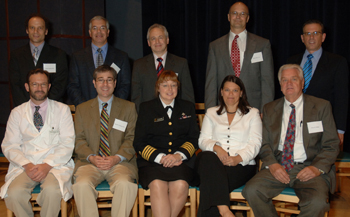 |
|
(from left, back row) Drs. Adrian Zelazny, Patrick Murray, Anthony Suffredini, Pierre Noel, Frederick P. Ognibene (front row) Drs. Steven Holland, David Greenberg, and Michele Evans, and Lisa Lacasse and Jim Wilson received awards at the NIH Director’s Awards ceremony.
|
The 2007 NIH Director’s Awards ceremony on June 13 recognized several Clinical Center staff.
NIH Director Dr. Elias Zerhouni honored five CC staffers with individual awards: Dr. Deb Gardner, chief of Workforce Planning and Development, for outstanding mentoring on enhanced methods for organizational development; Lisa Lacasse, chief financial officer, for outstanding CC budget management; Dr. Pierre Noel of DLM and NIH OD, for service as a physician and manager with special expertise in emergency preparedness; Dr. Frederick P. Ognibene, director of the Office of Clinical Research Training and Medical Education, for exemplary leadership and direction of the Clinical Research Training Program and Clinical Investigator Student Trainee Forum in support of the NIH Roadmap; and Dr. Anthony Suffredini, senior investigator in CCMD, for creating a comprehensive program in the genomics and proteomics of critical illness.
Two CC group awards were also presented. Dr. Patrick Murray, chief of the Microbiology Service in the CC’s Department of Laboratory Medicine, along with his NIAID colleagues Drs. David Greenberg, Steven Holland, and Adrian Zelazny, received a group science award for the identification of a new bacterial pathogen, Granulibacter bethesdensis.
 |
|
(from left) William Lofton, John Franco, and Boniface Lansiquot from DCRI were among award recipients.
|
Dr. Michele Evans, hospital safety officer, and Jim Wilson, chief of CC Facilities Management, were awarded for their vigilance in upholding the safety and integrity of the CC’s environment of care.
Dr. Christine Grady, head of the Section on Human Subjects Research in the CC Department of Bioethics, received an NIH Roadmap award as part of the NCRR group of CTSA Roadmap subcommittee chairs and co-chairs.
John Franco, William Lofton, and Boniface Lansiquot from DCRI received an award as part of the NIH Information Security Program Team for sustained contributions to the NIH mission.
LCDR Lisa Marunycz received a PHS outstanding service medal for leadership during the CRC move. Marunycz and retired CAPTs Laura Chisholm and Charles McGarvey, received an outstanding unit citation for CRC patient move logistics.
Back to Top
Dr. Elaine Jaffe gives 2007 Decker Lecture
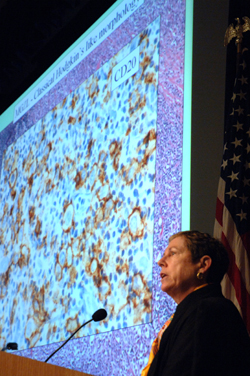 |
|
Dr. Elaine Jaffe delivers the 2007 Decker Memorial Lecture on June 20.
|
The fourth in a series honoring NIH’s leaders in clinical teaching, the 2007 John Laws Decker Memorial Lecture on June 20 highlighted the accomplishments and research of Dr. Elaine Jaffe. Named the NIH Fellows Committee’s 2006 Distinguished Clinical Teacher—the highest honor bestowed collectively on an NIH senior clinician, staff clinician, or tenure/tenure-track clinical investigator by the NIH Clinical Fellows—Jaffe was invited to deliver the 2007 address.
Chief of the Hematopathology Section and acting chief of the Laboratory of Pathology at NCI’s Center for Cancer Research, Jaffe came to NIH in 1970 as a resident in anatomic pathology and has been a senior investigator since 1974. Her current area of expertise is in the relationships between the immune system and malignant lymphomas and leukemia. In her lecture, Jaffe described how microscopy complements molecular diagnostic technologies and illustrated its role in describing Hodgkin’s disease, anaplastic large cell lymphoma, and in situ follicular lymphoma.
|
Previous NIH Distinguished Clinical Teachers Awardees
|
- 2005 Dr. Lynnette Neiman (NICHD)
- 2004 Dr. David Goldstein (NINDS)
- 2003 Dr. Michael Bishop (NCI)
- 2002 Dr. Steven M. Holland (NIAID)
- 2001 Dr. Thomas J. Walsh (NCI)
- 2000 Dr. Crystal Mackall (NCI)
- 1999 Dr. Susan Leitman (CC)
- 1998 Dr. Dimitrios Boumpas (NIAMS)
- 1997 Dr. John Doppman (CC)
- 1996 Dr. James Balow (NIDDK)
- 1995 Dr. Maria Turner (NCI)
- 1994 Dr. John Bennett (NIAID)
- 1993 Dr. Henry Masur (CC)
- 1992 Dr. David Rubinow (NIMH)
- 1991 Dr. Fernando Cassorla (NICHD)
- 1990 Dr. John Klippel (NIAMS)
- 1989 Dr. James Shelhamer (CC)
- 1988 Dr. Anthony Fauci (NIAID)
- 1987 Dr. Alan Baker (NCI)
- 1986 Dr. Joseph Parrillo (CC)
- 1985 Dr. Lynn Loriaux (NICHD)
|
John Laws Decker began his career at NIH in 1965 as chief of the Arthritis and Rheumatism Branch, which is now NIAMS. He was director of the NIH Clinical Center from 1983 to 1990 and was named scientist emeritus following his retirement.
The 2007 Distinguished Clinical Teacher Awardee will be announced by the members of the NIH Fellow’s Committee at the CC’s Grand Rounds this fall and will be the invited lecturer at the John Laws Decker Memorial Lecture, sponsored by the CC and the Foundation for NIH, as part of the Great Teachers series of Grand Rounds in June 2008.
Back to Top
A welcoming first impression
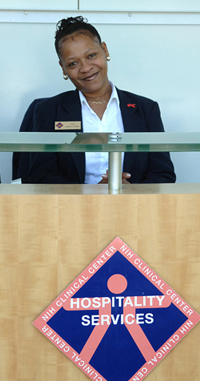 |
Letitia Johnson, at the CC for 22 years
Job: Hospitality service representative for the West Drive and Cedar Lane patient entrance.
|
Most people in Building 10 know how helpful and friendly the customer service support representatives at the hospitality desks around the Clinical Center can be for patients, visitors, and staff. But did you know that there are also hospitality staff at the patient entrance at West Drive and Cedar Lane near the Children’s Inn?
Meet Letitia Johnson. She greets our patients at the West Drive entrance while they undergo security screening and help direct them on where to go and what to expect during their stay. She gives patients and their companions the resources to arrive on time for their appointments.
The patients who come through the West Drive entrance are often new admissions, according to Denise Ford, chief of CC Hospitality Services. They haven’t had a chance to get oriented or to receive an extended visitor badge. "They’re brand new here. They don’t know what they should do or where they’re going, and they’re often dragging luggage with them," Ford said.
The West Drive entrance is ideal for ill patients or those who have difficulty walking, as they don’t have to get out of their cars or shuttles. Security guards will wand them in place and assist in processing their identification and luggage through the screening facility. If patients arrive through the entrance near the Metro in a car or on a shuttle, the patient has to step out of the vehicle, haul their own luggage, and walk through the Gateway Screening Center. West Drive provides personalized service for patients.
Johnson thinks the flow of traffic has increased a great deal since the entrance opened, a hunch Ford confirms: The entrance, which as of June 18 is open 7 a.m. to 7 p.m., welcomes approximately 700-800 people each week, primarily from hotel and airport shuttles, cabs, and private vehicles.
As a hospitality representative, Johnson often creatively solves patient issues while meeting security requirements. "I love coming to work every day. My job comes naturally to me. I love meeting the patients and getting to know them," Johnson said.
Back to Top
Organ transplant brings hope, gratitude to CC physician
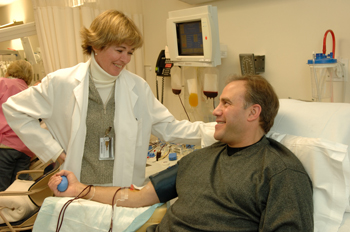 |
|
Dr. Cathy Cantilena, DTM, talks with donor Scott Kaufman, who recently made his 100th donation to the NIH blood bank. Cantilena tells the donors she meets, "You’re the celebrity here because you’re giving people like me life." Kaufman and his brother, Lloyd—who is about to make his 100th donation—contribute regularly in memory of two family members who died from cancer. "I wanted to do something to help cancer patients to survive," Kaufman said. In addition, he feels that donating is a "wonderful gift and legacy" for his family and he hopes that his children will be inspired to donate as a recognition that they are blessed with good health. "It’s a subtle but powerful thing to share your health," Kaufman said.
|
Dr. Cathy Cantilena, staff physician in the Department of Transfusion Medicine and an NIH employee since 1989, doesn’t wear an iPod when she exercises outside. She doesn’t want anything to block out the sound of the birds singing. For Cantilena, listening to the birds is part of appreciating the gift of her life, and their songs bring her hope for another day. In her office, a statue of an angel with a bird perched on her arm lifts her spirits. Its inscription, "hope is like a little bird that sings," reminds her that she is living another day.
Cantilena began her tenure at NIH in NHLBI assisting patients diagnosed with rare or new diseases. Later, she worked under the mentorship of Dr. Harvey Alter, chief of Transfusion Medicine’s infectious disease section, when he and colleagues identified the hepatitis C virus. She never could have guessed that NHLBI physicians in 2000 would diagnose her with a rare disease—lymphangioleiomyomatosis (LAM), where an unusual type of muscle cell invades the tissue of the lungs, including the airways, blood, and lymph vessels. Over time, these muscle cells grow into the structures’ walls, causing obstructions. The muscle cells begin to block circulation to and from the lungs, preventing the lungs from providing oxygen to the rest of the body. Unique to women of child-bearing age, LAM has no known treatment aside from transplantation. Only about 800-900 women in the U.S. have it.
Cantilena said she was very good at ignoring symptoms that something might be wrong. One day, while playing with her children in the ocean, she couldn’t breathe, jump the waves, or carry on a conversation while walking. She also started to lose weight rapidly. In 2005, she decided to seek treatment at the Duke Lung Transplant Center and passed the rigorous pre-operative evaluation in January 2006. She soon knew that she had made a good choice: Duke places transplant patients together in small groups so that they can journey together through the process of preparing for, undergoing, and recovering from surgery. "The camaraderie was wonderful," Cantilena said.
In early March of that year, Cantilena’s condition deteriorated rapidly after she caught a virus that weakened her lungs. She experienced a "code blue" lasting six to eight minutes—long enough for physicians to worry about brain death—and went into a coma for four days. Though still on a ventilator, she opened her eyes from the coma and jumped to the top of the waiting list for lungs. She received her transplant on March 8, 2006, and the next day was awake breathing the air in her hospital room. Although she was in the ICU for two and a half weeks, Duke’s post-discharge program until May, and rehabilitation after that, Cantilena returned home and to work at NIH by early June, less than three months after her transplant.
Dr. Harvey Klein, chief of the Department of Transfusion Medicine, remarked on Cantilena’s "amazing ability to contribute to the CC clinical care effort right up to the time of transplant, as well as her remarkable return. This is a physician who carried her oxygen tank to work and to the clinic up until days before she left for Durham for her lung transplant. We considered it a miracle that she recovered so quickly and a blessing that she returned so quickly to our hospital. She is an inspiration to the physicians whom she trains in transfusion medicine and an example of the difference that organ and blood donors can make."
"It’s a miracle I’m here," Cantilena said. "I’m alive. The sky is blue. I attended my daughter’s first Holy Communion, watched my middle schooler’s soccer games, and saw my son graduate from high school. I am here to contribute to their lives. That’s the ripple effect of organ donations. You get life back." The prognosis for Duke transplant patients is 89 percent one-year survival, 72 percent three-year survival, and 69 percent five year-survival. At the one-year anniversary of her transplant, Cantilena is proud to be part of that 89 percent statistic, and she knows that she will need to stay vigilant for infections that could compromise her ability to reach the five-year mark. Her immunosuppressed state requires some lifestyle changes, such as avoiding classrooms, large crowds, and uncooked vegetables—all of which could harbor bacteria and viruses. "But you can’t live in fear of setbacks," she said. "I just like to listen to the birds singing and smell the fresh air. It’s so nice not to have to worry about every breath!"
Cantilena said her experience provided her with an enormous sense of gratitude, especially to her family, friends, and colleagues who helped her through it. She wants to do everything she can to increase awareness of the importance of organ and blood donation. Cantilena received massive transfusions throughout her organ transplant; she needed 15 blood donors, including three platelet donors. She encourages everyone who is healthy to donate blood regularly, to consider becoming an organ donor, and to discuss those decisions with family members. "Make that contribution and live life to the fullest every day," she said.
As a physician, Cantilena said she is at the CC to contribute to research, and she appreciates the ability to take as much time as needed for patient and donor interactions. "I really take my time and value every minute. Taking the time with people is so important. It is so important to preserve hope for patients."
Back to Top
Two CC staffers participate in show of NIH scientists’ art
 |
|
Larry Bauer and Lorraine Caruccio, holding her acrylic painting "Fire" from her "Four Elements" series.
|
Creating art is nothing new for Clinical Center employees Lorraine Caruccio and Larry Bauer. But the opportunity to exhibit their work on the walls of Building 10 is.
Caruccio, research scientist in the Department of Transfusion Medicine, and Bauer, patient recruitment specialist in the Office of Patient Recruitment and Public Liaison, are two of the 32 NIH artists participating in an exhibit showcasing some of their creative talents other than the ones they apply on the job.
The idea came from Deanne Alpert, who came to NIH a year ago as a post-baccalaureate Institutional Research Training Award recipient in NHLBI. She noticed that scientists often expressed themselves through music, such as the NIH Chamber Orchestra and the NIH Chamber Singers. Alpert, however, balances her science work with drawing, painting, and attending exhibits at art museums, and hoped to identify other NIH scientists who are also visual artists. "Being creative outside of science helps to increase problem-solving in the laboratory or elsewhere," she said.
Alpert hoped that by designing a scientist-focused show, CC patients and non-scientific NIH staff would consider the scientific community in a new light and see the results not only of their analytic thinking, but also their creative instincts. It’s also beneficial for scientists to have the opportunity to display their work within their own community, and possibly inspire other scientists, she said.
Lillian Fitzgerald, curator of the CC galleries; Crystal Parmele, director of the CC art program; and Alpert judged submissions for the show. Although they planned to select only 20 pieces, after seeing the artists’ diverse talent—with works including photography, drawing, quilts, Chinese brush print, glass, embroidery, and origami—they expanded the event to include one piece from each of the 32 artists. The jury sought images appropriate for a hospital setting that reflected the artists’ individuality.
 |
|
"Succulent #1," Bauer’s enhanced photograph with saturated color, printed on canvas, and finished with high gloss
|
Both Bauer and Caruccio enjoy exhibiting their work and value the new outlet the show provides. For Bauer, who holds a bachelor’s of fine arts and designs advertisements and flyers for PRPL, his art is a place to create without constraints, such as size or color. His cactus photograph is one of several images captured about a year ago at the Getty Museum’s gardens in Los Angeles. The vivid colors added by computer reflect the love of saturated, pure color found in the deserts of India and Mali.
Caruccio, who studied art privately since childhood and at Glen Echo and the Smithsonian, in 2005 won the annual program design contest for the DTM/American Red Cross joint symposium on blood banking. She’s known for realistic portraits of people, animals, flowers, and landscapes, but her series in the CC exhibit is an example of her exploration of abstract painting. "I’m having fun with the freedom abstract art provides," she said.
Bauer remembers enjoying CC art shows and discussing them with patients since he began working here as a clinical research nurse in 1991, and both artists agree that the original, changing art exhibits on the CC’s walls make this hospital unique. Caruccio said she was excited to participate in an art event at NIH. "We have a lot of diverse talents here making NIH even more special than most people realize."
CC patients, visitors, and staff can enjoy the exhibit, which is located in the gallery near phlebotomy, until August 31.
Back to Top
Nurse Georgia Johnson retires after 34 years
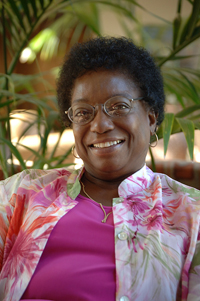 |
Georgia Johnson
|
by Louise Canada
On May 24, Georgia Johnson celebrated her retirement on 5NW after 34 years of nursing at the Clinical Center with family and CC staff.
Johnson said she always wanted to be a nurse. Unable to afford nursing school tuition immediately after high school, Johnson worked for 10 years as a cosmetologist and applied in 1972 to Washington, D.C.’s Martha Murray Washington School of Nursing, where she graduated as a licensed practical nurse in 1973.
She began her career at the CC on the 2 East pediatric oncology unit caring for children with leukemia. After seven years there, Johnson worked on the cardiac step-down unit on 6 West from 1980-1993 taking care of pre and post-operative cardiac surgery patients. While working full time, Johnson earned her associate degree in nursing in 1985 and her Bachelor of Science in nursing in 1987, both from the University of the District of Columbia.
When the cardiac surgery program ended in 1993, Johnson transferred to 10D-ICU, administering Taxol IV to oncology patients, for a year. She joined the pulmonary unit nursing staff on 7 West from 1994-1996. From 1996-2005 Johnson worked on 8 East, a hematology, pulmonary, bronchoscopy, and liver unit. With the move to the CRC, 8 East and 8 West staff merged on 5NW, where Johnson most recently worked.
Johnson also earned a certification in starting retrograde IVs, which are inserted "backwards" into veins in order to obtain de-oxygenated blood for a free fatty acid protocol. There are special challenges in keeping these retrograde IV lines patent, as they tend to clot off more readily than conventional IV lines.
Johnson and her husband, Joe, are celebrating their 47th wedding anniversary this year. They have two daughters, Valinda and Daisy; a son, Joe Jr.; and a granddaughter, Jamihlia, who is currently a high school exchange student in Paris, France.
"I love people and I love to help people. There’s nothing any better than that," Johnson said. She plans to return to the CC as a part-time contract RN later this year.
Back to Top
Brookside Gardens bench honors Mrs. M
 |
|
Attending the dedication were: back row (from left to right): Lynette Purdue; Jim Wilson; Erleen Gillis; Renan Bonnel; Roger Goetsch; Cecelia Parise; Karen Sillers; Evelyn Farinas; Barry Nishikawa; Cathie Schumaker; Bob DeChristoforo; Ron Brown; and Mary Guilderson. Front row (from left to right): Tim Ames; Richard Moeller, Moeller’s son; Leah Westbrook, Moeller’s granddaughter; Kristin Westbrook, Moeller’s daughter; and Jim Minor.
|
"I went to work when the Clinical Center was a beautiful new building with pools, azaleas, and marble benches," Delphine Moeller, secretary to three CC pharmacy chiefs, said in 1996 as she retired and reflected upon her CC experience. She was affectionately known to everyone as "Mrs. M."
On April 21, 2007, Moeller's colleagues and friends gathered to honor her and informally dedicate a wood bench near Brookside Gardens' azaleas to pay tribute to her 41 years of service.
Moeller, who started at the CC in 1955 and transferred to the Pharmacy Department in 1960, served chiefs Milton Skolaut, Joseph Gallelli, and Charles Daniels.
After her death in 2002, NIH staff contacted Brookside Gardens to investigate obtaining a bench in the park, which Moeller visited whenever she could. Although there was a waiting list for benches, Moeller’s was finally installed and the plaque mounted in October 2004.
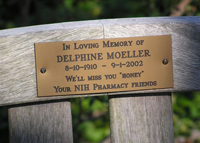 |
|
A plaque on the bench honors Moeller’s life.
|
More than 100 CC pharmacy employees past and present contributed to the bench. The money collected for benches finances a Brookside Gardens internship fund.
Back to Top
Mirabal Sisters’ middle school students explore Clinical Center
 |
The Mirabal Sisters group with CC Director Dr. John I. Gallin (center)
|
Middle school students from the Mirabal Sisters Campus, a community school operating in Harlem, New York, in collaboration with The Children’s Aid Society, spent the afternoon of May 4 at the Clinical Center exploring some of the diagnostic and therapeutic tools available to clinical researchers.
After a welcome and introduction from CC Director Dr. John I. Gallin, who compared the workings of a clinical research hospital to a city, the students participated in interactive presentations about DNA, science and probability, using virtual colonoscopy to find polyps, and laboratory medicine.
CC staffers Trang Bui, Karen Byrne, Teresa Genson, Paul Jabour, Tor Moore, Migdalia Rivera-Goba, Dr. Celeste Roney, Kelley Smith, Kathleen Spaid, and Dr. Gwenyth Wallen, as well as NHGRI's Hailey Edwards and Drs. William Gahl and Melissa Merideth, organized presentations for the students and helped to make the visit a success.
Back to Top
Bushy Park Elementary School science fair winners tour CC
 |
|
The Bushy Park students and their projects included (back row, from left): Mitchell Furst, how accurate are the weathermen?; Reny Barrett, water desalination; Jessica Cooper, water flow in plants; Grant Schultheis, kinetic energy. (front row, from left): Katie Ogorzalek, capillary attraction; Ryan Kato, electromagnetism; Matt Ogorzalek, airplane wing structure; Anna DeSantis, composting; Daniel Poltorek, electricity; Alex Barrett, do I have to brush my teeth?; and Kara Miller, color of drink vs. taste. Not pictured: Max Trumper, bike-powered CD player.
|
The 12 winners of the Bushy Park Elementary School’s science fair toured the Clinical Center on May 18. Dr. Gregory Kato, staff clinician in CCMD and director of NHLBI’s Sickle Cell Vascular Disease Unit, collaborated in judging the projects and hosted the students, who ranged in age from kindergarten through fifth grade.
NHLBI nurse Inez Ernst gave the young visitors toy stethoscopes to keep, taught them how to listen to their heart beats, and demonstrated an echocardiogram. Daniel Poltorek, who celebrated his sixth birthday that day, left the CC with a picture of his heart from the echocardiogram.
Joshua Joseph and Candice Bereal, Clinical Research Training Program medical students, showed the students a method of testing blood circulation in the forearm.
Kato involved the students in microplate protein assays. Dr. Nalini Raghavachari of CCMD and the NHLBI Genomics Core Facility, assisted by NHLBI’s Ronald Cooper, demonstrated gene expression microarray analysis and use of robotics.
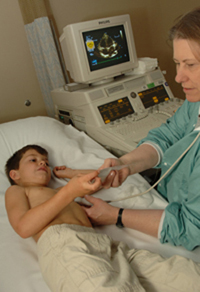 |
|
NHLBI nurse Inez Ernst gives Daniel Poltorek, who celebrated his sixth birthday the day of the tour, a picture of his heart from the echocardiogram.
|
The students learned about gait analysis in the CC Rehabilitation Medicine Department’s Clinical Movement Analysis Laboratory from Physical Disabilities Branch members Alex Razzook and Dr. Saryn Goldberg.
The enthusiastic students and their parents left the CC with a newfound appreciation for the range of available scientific research careers.
Back to Top
Poster session caps CRTP fellows’ experience
 |
|
Pretesh Patel, a fellow with the NIH Clinical Research Training Program, stands by his poster at the CRTP poster session.
|
Pretesh Patel, a fellow with the NIH Clinical Research Training Program, stands by his poster on the effect of anti-angiogenic treatment on radiofrequency ablation of squamous cell carcinoma in mice at the CRTP poster session outside of Lipsett Amphitheater on June 6. Patel’s mentor is Dr. Brad Wood, co-acting director of the CC’s Diagnostic Radiology Department.
Back to Top
Principles of Clinical Pharmacology class starts in September
The 2007-2008 CC Principles of Clinical Pharmacology course will begin on September 6 in Lipsett Amphitheater. The course will be held Thursdays from 6:30 p.m. to approximately 7:45 p.m. and will run through April 24, 2008. The registration deadline is August 23.
"Many medical schools don’t offer formal courses in clinical pharmacology," said CC Director Dr. John I. Gallin. "This program covers what researchers need to know concerning the clinical pharmacologic aspects of drug development and use." The course covers topics such as pharmacokinetics, drug metabolism and transport, assessment of drug effects, drug therapy in special populations, and drug discovery and development.
Dr. Juan Lertora, director of CC clinical pharmacology and course director since July 2006, said an outstanding faculty has been assembled to present the lectures, drawing from NIH scientific staff, FDA, the pharmaceutical industry, and many prestigious U.S. academic institutions. The faculty, led by former course director Dr. Arthur J. Atkinson, Jr., prepared a textbook, Principles of Clinical Pharmacology, Second Edition (2007), which follows the lectures and is available in the FAES bookstore.
The course has expanded beyond the CC to include off-site partners since it began 10 years ago. Last year there were about 240 students from 10 long-distance partners in addition to the nearly 400 enrollees at NIH. "We have been very pleased with the great interest generated by this course and the increasing number of registrants over the past several years," Dr. Frederick P. Ognibene, director of the CC’s Office of Clinical Research Training and Medical Education, said.
Registration is open to all interested individuals at no cost, unless the course is being taken for graduate credit through FAES as PHAR 500 I and PHAR 500 II. Contact FAES at 301-496-7976 for credit. Certificates will be awarded at the end of the course to all students attending 75 percent of the lectures.
Course information, including online registration, is available at www.cc.nih.gov/ccc/principles or by calling 301-435-6618.
Back to Top
News Briefs
CC pharmacist receives national honors
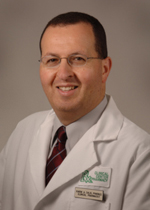 |
Karim Calis
|
Dr. Karim Anton Calis, CC Pharmacy Department, has received the PHS Allen J. Brands Clinical Pharmacist of the Year Award for excellence in patient care, teaching, and clinical research. Calis directs the department’s Drug Information Service and is a clinical specialist for endocrinology and women’s health. He holds the rank of professor with the Medical College of Virginia, Virginia Commonwealth University and clinical professor with the University of Maryland. He was recently appointed to the Executive Committee of the Council of Experts, U.S. Pharmacopeia (USP). He chairs the USP Endocrinology Expert Committee and is vice chair of the Model Guidelines Expert Committee. A fellow of the American College of Clinical Pharmacy and the American Society of Health-System Pharmacists, Calis was in 1992 among the first in the U.S. to be certified in two specialties—pharmacotherapy and nutritional support—by the Board of Pharmaceutical Specialties. Honors include the ASHP Foundation’s Pharmacy Practice Research Award in 2001, the 2002 Award for Excellence in Clinical Pharmacy Practice from the Association of Military Surgeons of the United States, election as a Distinguished Practitioner by the National Academies of Practice in 2004, and recognition as an honored alumnus by the University of Maryland School of Pharmacy in 2005.
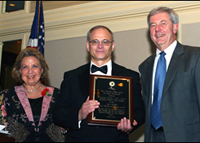 |
Dr. William Gahl (center) receives the NORD Public Health Leadership Award from NIH Office of Rare Diseases Director Dr. Stephen Groft (right) and Estelle Benson from the NORD Board of Directors.
|
NHGRI Clinical Director Gahl honored by rare-disease community
The National Organization for Rare Diseases presented Dr. William Gahl, clinical director of NHGRI and director of the Intramural Research Program of the NIH Office of Rare Diseases, with its public health leadership award at the 2007 NORD tribute banquet on May 21. The annual event recognizes individuals and companies making significant contributions to improving the lives of those with rare diseases. Gahl is an internationally known expert on cystinosis, Hermansky-Pudlak syndrome, alkaptonuria, and sialic acid metabolism disorders.
CC News expands distribution
The Clinical Center News in June redesigned and increased the number of distribution boxes throughout Building 10. Print copies remain available outside the B1 and second floor cafeterias, as well as in the first floor breezeway between DCRI and the main elevators. Two new boxes were added in the South and North lobbies. The boxes’ new look reflects the newsletter’s updated style, adopted in April 2006 with the one-year anniversary of the move to the Hatfield building. CC News is also available online at www.cc.nih.gov/about/news/newsletter.html.
Back to Top
New clinical research protocols
The following new clinical research protocols were approved in May:
The Influence of Lopinavir/Ritonavir on Gemfibrozil Pharmacokinetics in Healthy Volunteers, 07-CC-0149, Kristin Busse, PharmD, CC
Effects of Peripheral Blood Stem Cell Transplantation on the Microbial Flora of the Oral Cavity, 07-CC-0153, Nancy Ames, RN, CC
Effects of S-Adenosyl Methionine (SAMe) on Viral and Cell Signaling Response to Combination Therapy for Chronic Hepatitis C, 07-DK-0143, Apurva A. Modi, MD, NIDDK
Ocular Impact of X Chromosome Karyotype and Sex Hormones in Turner Syndrome and Premature Ovarian Failure, 07-EI-0145, Janine A. Smith, MD, NEI
Research Respiratory Tract Procedures in Healthy Adult Volunteers and Adult Patients to Obtain Specimens for In Vitro Analyses of Infection Pathogenesis and Susceptibility, 07-I-0142, Kenneth N. Olivier, MD, NIAID
Phase I/IIa Multicenter Dose-Escalation Study of Subcutaneous Intermittent Interleukin-7 CYT107 in Chronically HIV-Infected Patients with CD4 T-Lymphocyte Counts between 101-400 Cells/mm(3) and Plasma HIV RNA less than 1000 Copies/ml after at least 12-m HAART, 07-I-0155, Irini Sereti, MD, NIAID
VRC 012: A Phase I Clinical Trial of the Safety and Immunogenicity of an HIV-1 Adenoviral Vector Serotype 35 Vaccine: Dose Escalation as a Single Agent and Prime-Boost Schedules with an HIV-1 Adenoviral Vector Serotype 5 Vaccine in Uninfected Adults, 07-I-0167, Barney S. Graham, MD, NIAID
An Investigation of the Antidepressant Effects of the Selective NR2B Antagonist MK-0657 in Major Depression, 07-M-0152, Carlos A. Zarate, MD, NIMH
Effect of Direct Current Brain Polarization on Verbal Memory, 07-N-0147, Eric M. Wassermann, MD, NINDS
Influence of Lesion Location on Cortical Reorganization after Chronic Stroke, 07-N-0154, Leonardo G. Cohen, MD, NINDS
Biomechanics of Human Epiglottal Movement and Inversion, 07-N-0156, Christy L. Ludlow, PhD, NINDS
Pilot Study of Botulinum Toxin Type A for the Treatment of Restless Legs Syndrome, 07-N-0160, Fatta B. Nahab, MD, NINDS
Back to Top
Clinical Center News, National
Institutes of Health, Building 10, 10 Center Drive, Room 12C440, Bethesda, MD 20892-1504. Tel: 301-496-6787.
Fax: 301-402-2984. Published monthly for CC employees
by the Office of Communications, Patient Recruitment, and Public Liaison. News, article ideas,
calendar events, letters, and photographs are welcome.
Back to Top
|
|


 The information on this page is archived and provided for reference purposes only.
The information on this page is archived and provided for reference purposes only.